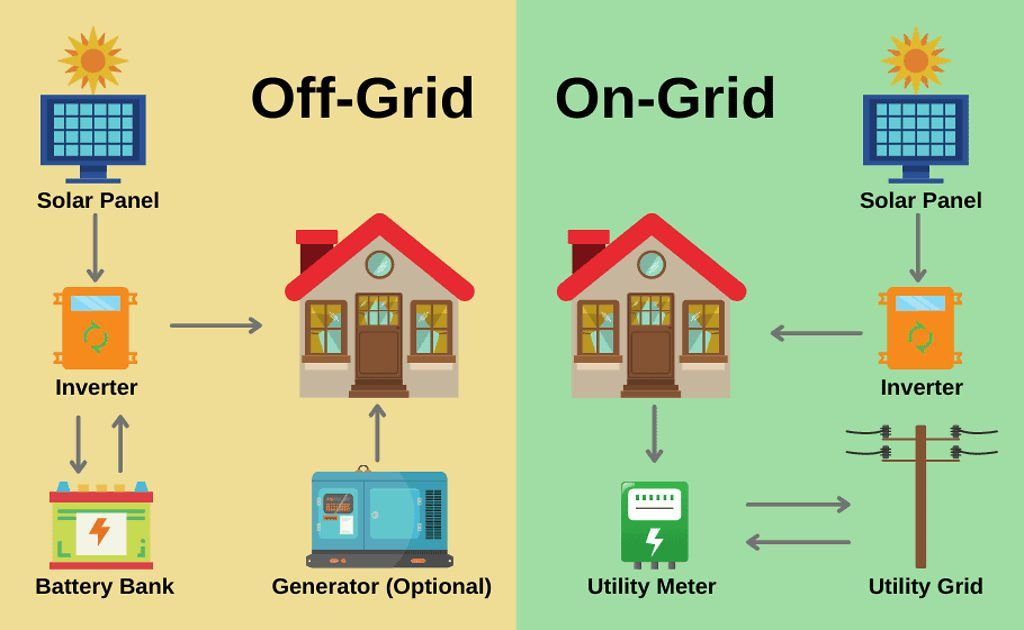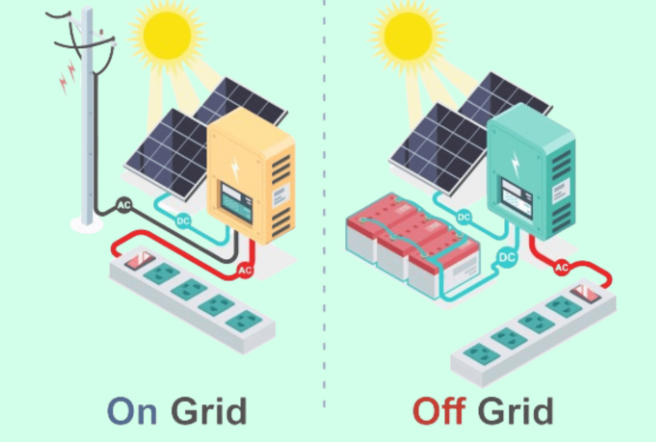The Difference Between Off-Grid and Grid-Connected Energy Storage Systems
The main differences between off-grid household photovoltaic energy storage systems and grid-connected household photovoltaic energy storage systems are as follows:
1.System Connection Method
The off-grid system operates independently of the power grid. It is mainly composed of photovoltaic modules, energy storage systems (such as batteries) and inverters to form a self-circulating power supply system. The direct current generated by the photovoltaic modules is first stored in the energy storage battery, and then converted into alternating current through the inverter for use by electrical appliances in the home. This system is not connected to the external power grid and relies entirely on its own power generation and energy storage to meet the household electricity needs.
The grid-connected system is connected to the public power grid. In addition to photovoltaic modules, energy storage systems and inverters, there are also grid-connected inverters and electric meters. After the direct current generated by the photovoltaic modules is converted into alternating current through the inverter, part of it is used for electrical equipment within the home, and the excess power can be transmitted to the power grid through the grid-connected inverter; when the photovoltaic system generates insufficient power, the home can obtain power from the power grid, realizing a two-way flow of power.

2. Power Supply Stability
Off-grid type: The stability of its power supply depends entirely on the capacity of its own photovoltaic module power generation and energy storage system. In bad weather (such as cloudy and rainy days) or at night, when the photovoltaic modules cannot generate electricity, household electricity can only be provided by energy storage batteries. If the capacity of the energy storage battery is insufficient, there may be a power shortage, causing some electrical appliances to be unable to work normally. For example, on consecutive rainy days, the off-grid system may be out of power due to the exhaustion of the energy storage battery until the weather improves and the photovoltaic modules start to generate electricity again and charge the battery.
Grid-connected type: Since it is connected to the power grid, when the photovoltaic system generates insufficient electricity (such as at night or in low-light weather), the household can obtain electricity from the power grid, and there will be basically no power supply interruption, which can provide a more stable power supply. For example, even if the household photovoltaic system stops generating electricity at night, household electrical appliances can still be used normally because the electricity is provided by the power grid at this time.

3. Energy Efficiency
The energy efficiency of off-grid systems mainly depends on the power generation efficiency of photovoltaic modules, the charging and discharging efficiency of energy storage systems, and the conversion efficiency of inverters. Since energy needs to be converted and stored multiple times between photovoltaic modules, energy storage batteries, and electrical equipment, each conversion process will have a certain amount of energy loss, such as the battery charging and discharging process will produce energy loss.
In addition, in order to avoid over-discharging or overcharging of energy storage batteries, it may be necessary to limit the depth of charge and discharge of the battery, which will also reduce the actual efficiency of energy utilization.
When the photovoltaic system generates sufficient electricity, the grid-connected system can transmit excess electricity to the grid, reducing the phenomenon of abandoned light due to the capacity limitation of the energy storage system (that is, the electricity generated by the photovoltaic system cannot be effectively used), and improving the overall efficiency of energy utilization. In addition, the grid itself has the function of regulating and optimizing power distribution, which can better integrate and utilize the electricity generated by photovoltaic power generation.
When choosing an off-grid or grid-connected energy storage system, you should consider the specific application scenario, budget constraints, and the need for future power supply stability. Off-grid systems are suitable for areas without grid access, while grid-connected systems are more suitable for areas with stable grids and power supply needs. It is recommended to conduct detailed market research and cost-benefit analysis before making a decision, and consider long-term maintenance and technical support costs.





 English
English  English
English français
français русский
русский español
español português
português العربية
العربية 日本語
日本語 Melayu
Melayu Indonesia
Indonesia 中文
中文



 network supported
network supported